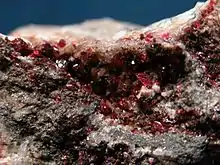| Rozenite | |
|---|---|
 Rozenite from Morocco | |
| General | |
| Category | Sulfate mineral |
| Formula (repeating unit) | Fe2+SO4·4(H2O) |
| IMA symbol | Rzn[1] |
| Strunz classification | 7.CB.15 |
| Dana classification | 29.06.06.01 |
| Crystal system | Monoclinic |
| Crystal class | Prismatic (2/m) (same H-M symbol) |
| Space group | P21/n |
| Identification | |
| Color | Colorless, white, pale green |
| Crystal habit | As concretions and nodules; most commonly as powdery efflorescences or coatings on melanterite |
| Mohs scale hardness | 2–3 |
| Luster | Vitreous to dull |
| Streak | White |
| Diaphaneity | Semitransparent |
| Specific gravity | 2.29 |
| Optical properties | Biaxial (−) |
| Refractive index | nα = 1.526 – 1.528 nβ = 1.536 – 1.537 nγ = 1.541 – 1.545 |
| Solubility | Water soluble |
| References | [2][3][4] |
Rozenite is a hydrous iron sulfate mineral, Fe2+SO4·4(H2O).
It occurs as a secondary mineral, formed under low humidity at less than 21 °C (70 °F) as an alteration of copper-free melanterite, which is a post mine alteration product of pyrite or marcasite. It also occurs in lacustrine sediments and coal seams. Associated minerals include melanterite, epsomite, jarosite, gypsum, sulfur, pyrite, marcasite and limonite.[2]
It was first described in 1960 for an occurrence on Ornak Mountain, Western Tatra Mountains, Małopolskie, Poland. It was named for Polish mineralogist Zygmunt Rozen (1874–1936).[2][3]
The thermal expansion of rozenite was studied from −254 °C (−425.2 °F) to 17 °C (63 °F) using neutron diffraction. Rozenite exhibits negative linear thermal expansion, meaning that it expands in one direction upon cooling.[5]
References
- ↑ Warr, L.N. (2021). "IMA–CNMNC approved mineral symbols". Mineralogical Magazine. 85: 291–320.
- 1 2 3 Rozenite in the Handbook of Mineralogy
- 1 2 Rozenite data on Mindat.org
- ↑ Webmineral data for rozenite
- ↑ "Scientific article rozenite" (PDF).